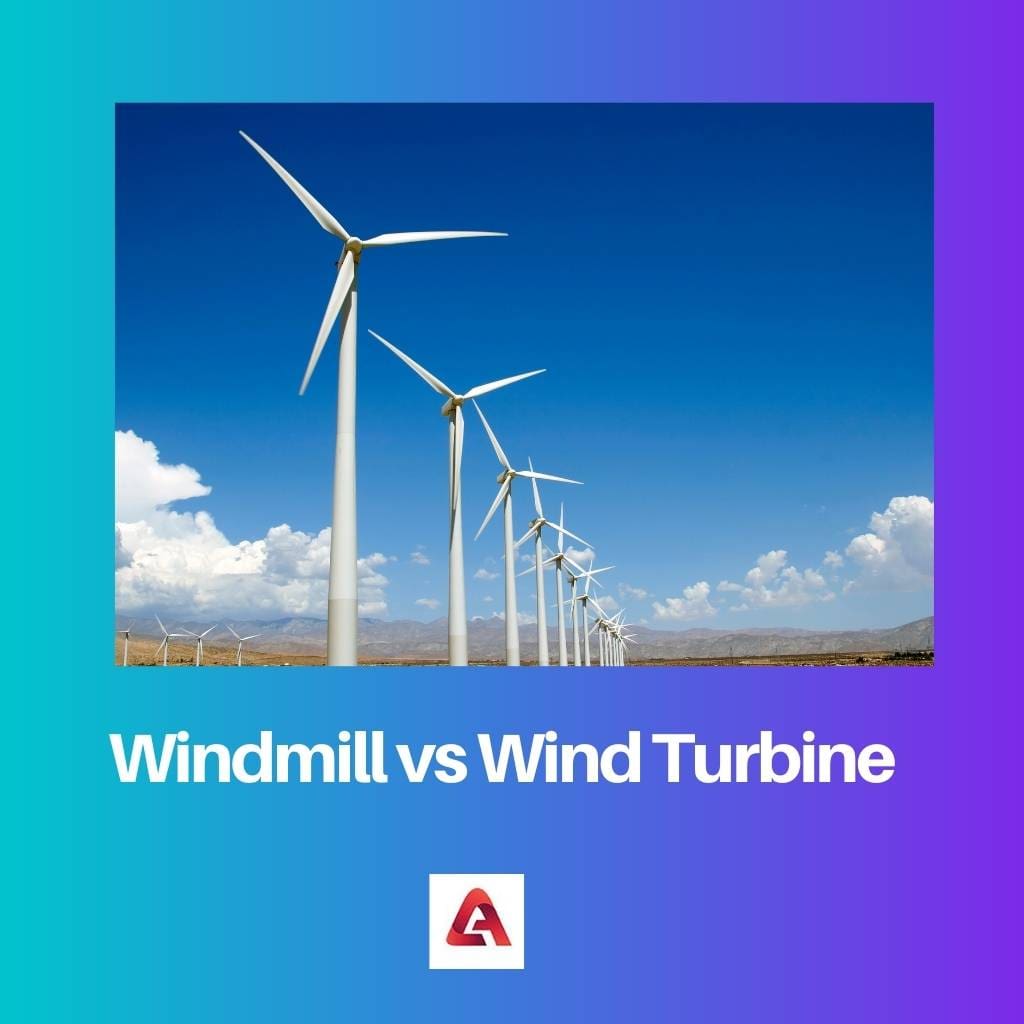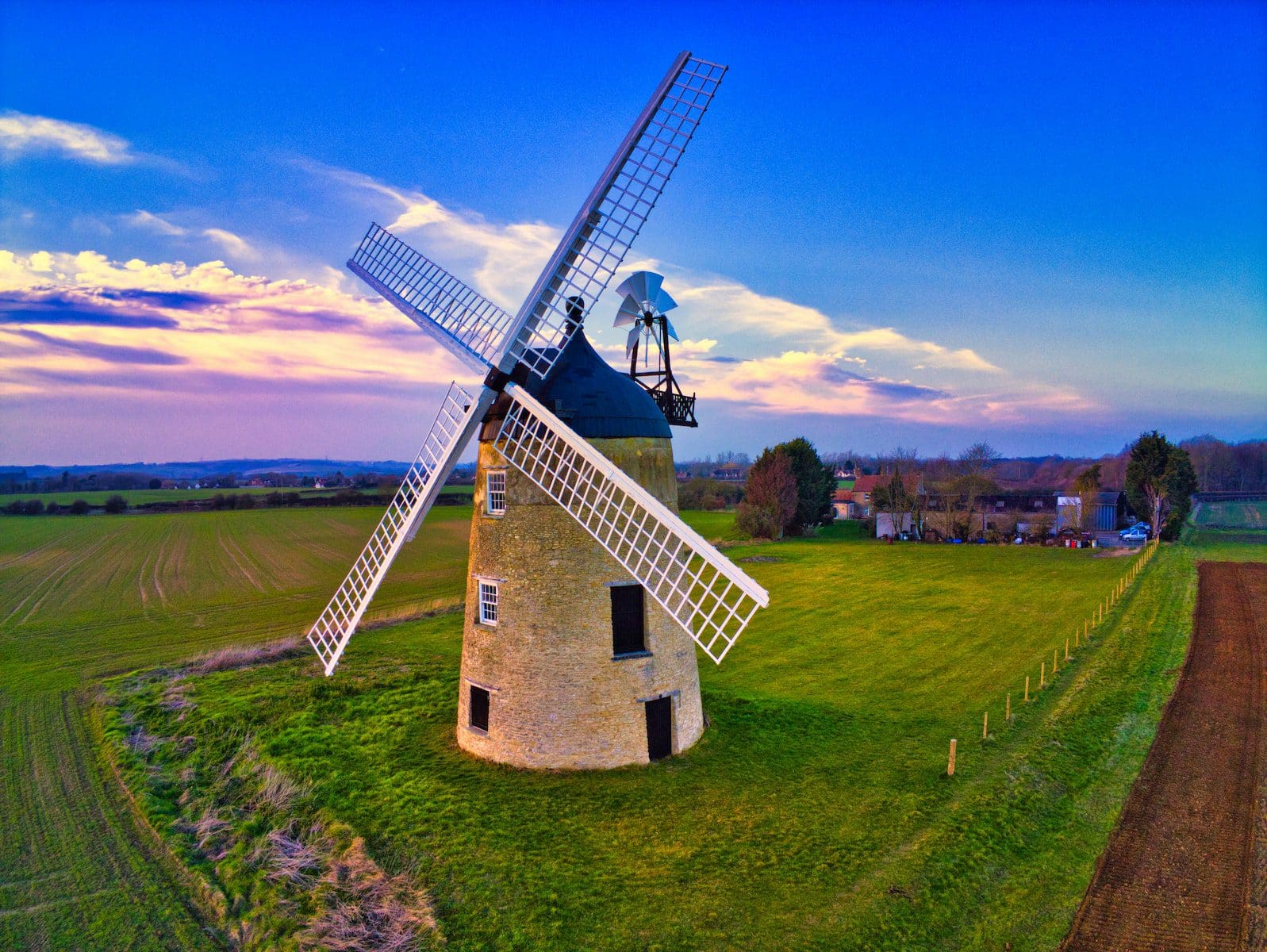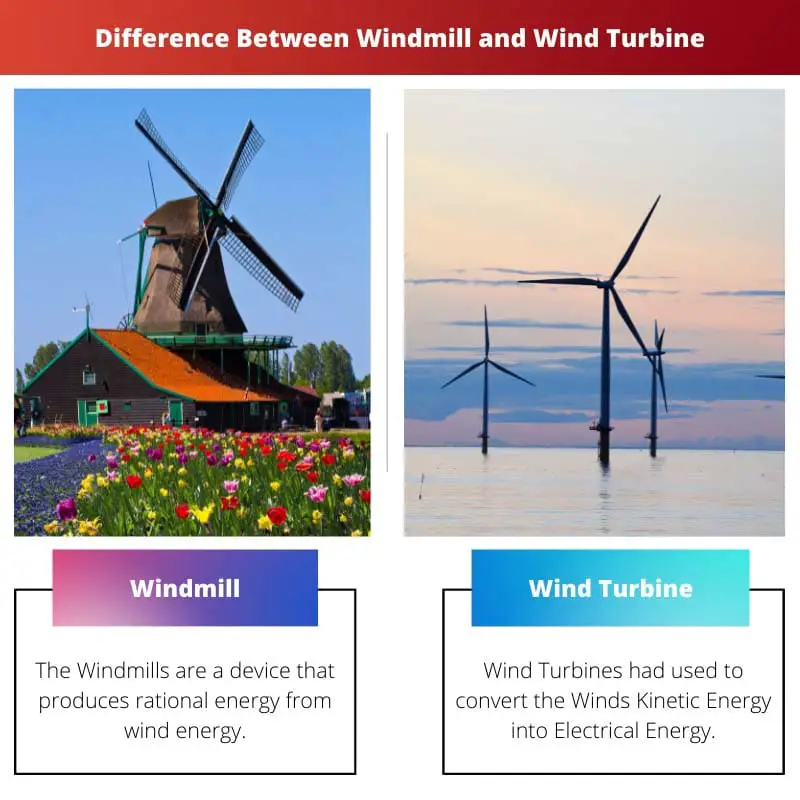Various Engines provide kinds of energy that are used for several purposes. A wind Engine is one of the types of engine.
Windmills and Wind turbines are wind engines used to generate the types of energy. Let’s dive into the details.
Key Takeaways
- Windmills are used for grinding grain or pumping water and have horizontal blades.
- Wind turbines generate electricity and have vertical blades.
- Wind turbines are larger and more modern than windmills, used for traditional purposes.
Windmill vs Wind Turbine
A windmill is a machine that uses wind power to grind grain into flour or pump water. A wind turbine is a device that converts wind energy into electricity, having a horizontal axis with large blades that are designed to capture the kinetic energy of the wind and turn it into rotational energy.

Windmills are a device that comes under Wind Engines, and these devices are used to convert power into rational energy. Windmill consists of vanes which are known as sails or blades.
The blades of the windmills help to convert the power into Rational energy. Windmills rotate with the assistance of wind, which helps to mill the grains and turns them into flour.
The flour that comes out from the windmills had been used to make pieces of bread.
Wind Turbines are Wind Engines that convert the wind’s Kinetic Energy into Electrical Energy. Wind Turbines had manufactured with extensive size, and these turbines are horizontal or vertical in axes.
The working principle of the Wind Turbine is to produce electricity from the wind, whereas the appliances like fans use electricity to generate a breeze.
Comparison Table
| Parameters of Comparison | Windmill | Wind Turbine |
|---|---|---|
| Meaning | The Windmills are a device that produces rational energy from wind energy. | Wind Turbines had used to convert the Winds Kinetic Energy into Electrical Energy. |
| Uses | Windmill was used to grind the grains that help in the bread making. | Wind Turbines had used to grind the grains and pumping water. |
| Structure | A building with four blades and rotates in a circular motion. | Turbines had manufactured with tubular steel that stands on the ground strength. |
| Comparison | Windmills are old generated devices, but the blades are small. | The blades of the Wind Turbines are large compared to the Windmills. |
| Invention | Windmills had introduced in 1854 August. | Wind Turbine had been introduced in 1887 by Prof James Blyth. |
What is Windmill?
Windmills are a device used to convert the power from winds into rotational energy. Windmills had introduced in August 1854.
Windmills are the old model that works with the help of winds. These had used to grind the grains into flour that helps in making bread.
Windmills consist of vanes which are known as sails or blades.
The Windmills consist of 4 blades which are smaller and attached to a building. The vanes of the windmills had made with carbon fibre, balsa wood, fibreglass, stable and inert materials.
The vanes of the windmills had organized with an angle that helped to work against the wind. The working principle of windmills is the wind causes the blades will spin and produce kinetic energy.
If the generator had connected to the Windmills, then that wind helps to generate electricity.
Post Mill, Tower Mill, Stock Mill and Fan Mill are the four types of Windmills. Vertical Windmills and Horizontal Windmills are the primary windmills distinguished based on the axis of rotation.
Windmills are old-generated mills constructed by buildings with three blades. The lifespan of the Windmills is 20 years, where maintenance had required for six months.
China Goudian Corporation, Goldwind, SANY, Shanghai Electric, Sinovel and others are the companies in China that manufacture Windmills. Although Windmills produce rotational energy, that energy is harmful to the fishes, animals and plants.
The blades of the Windmills are dangerous to birdlife like bats and many others.

What is Wind Turbine?
A Wind Turbine is a device that produces electricity from wind kinetic energy. Wind Turbine is one of the engines in Wind Engines.
These types of Wind Engines had used for grinding, pumping water generating electricity. Wind Turbines that produce electricity were introduced in 1888 by Prof James Blyth.
James Blyth was a professor at Andersons College, Glasgow.
In the 11th century, Wind Turbines had used for grinding in Northwestern Europe. In the 19th century, wind turbines had used to generate electricity through the wind in Scotland.
Containing few blades for wind turbines helps to reduce resistance, but two-bladed wind turbines do not work efficiently compared to three blades wind turbines. The vanes or sails of a Wind Turbine had manufactured with tubular steel, solar lattice and carbon fibre.
Most of the Wind Turbines had located on farms that helped in electricity production.
Steam, Gas, Wind, and Water are the four types of Turbines classified depending on the driving force. Wind Turbines had manufactured with extensive size, and these turbines are horizontal or vertical in axes.
At the time of peak winds, the Wind Turbines rise to 50% of efficiency. The wind will drop after going into the Wind Turbines if the efficiency reaches 100%.
If the wind blows 12 miles per hour, the power output is up to 1.5 megawatts from Wind Turbines.
The lifespan of the Wind Turbines was up to 20 years with good maintenance. Horizontal-axis and Vertical-axis are the two types of Wind Turbines, but most people prefer to use Horizontal-Axes turbines.
The reason for choosing the Horizontal-Axes turbine is that the strength and efficiency are higher than the Vertical-axes Turbines. The Wind Turbine blades are more secure and substantial in length than the Windmill blades.
Wind Turbines harm flying birds with sharpening blades.

Main Differences Between Windmill and Wind Turbine
- Windmills had introduced in 1854, and Wind Turbines were introduced in 1888 by prof James Blyth.
- Windmills and Wind Turbines are Wind Engines, but the construction and outputs differ.
- Windmill converts the Windpower into Rational energy, where the Wind Turbine is used to produce the electricity from Kinetic energy.
- Windmills consist of small blades or sails compared with Wind Turbines.
- Windmills and Wind Turbines are used for grinding grains and pumping water, but, Windmills produce electricity by generating a motor.

- https://www.sciencedirect.com/science/article/pii/S0960148108001754
- https://www.annualreviews.org/doi/pdf/10.1146/annurev.fl.15.010183.000453

The development timeline of windmills and wind turbines showcases the transformative potential of renewable energy, shaping the transition from mechanical power to electrical power generation for sustainable energy supply.
The synergy between historical windmill technology and contemporary wind turbine innovations underscores the seamless progression towards more efficient and environmentally conscious renewable energy systems.
The comparison table provides a clear overview of the differences between windmills and wind turbines. Understanding these differences is essential for making informed decisions about energy production.
This comparison table showcases the technological advancements in wind energy over the years, highlighting the transition from traditional windmills to modern wind turbines.
The invention and evolution of wind energy technologies reflect the progress of human innovation in harnessing natural resources for sustainable energy production.
The integration of wind turbines into energy infrastructure requires an interdisciplinary approach encompassing engineering, environmental science, and policy to optimize energy production while minimizing ecological impact.
Evaluating the environmental trade-offs and benefits of wind turbine deployment is essential for informed decision-making in energy planning and sustainable development.
The interdisciplinary consideration of wind energy highlights the interconnectedness of environmental, technological, and societal factors in advancing sustainable energy solutions.
The narrative of windmills and wind turbines reflects the evolving relationship between humankind and nature, illustrating the convergence of technological innovation and ecological stewardship in energy production.
Wind turbines are a crucial part of the transition towards renewable energy sources. The development of wind energy technology is essential to combat climate change.
As the demand for renewable energy grows, the role of wind turbines in meeting this demand will become increasingly significant. Investment in wind energy technology is crucial for a sustainable future.
The design of wind turbines has evolved to be more efficient and produce more energy with fewer negative impacts on the environment. The future of wind energy looks promising.
In addition to electricity generation, wind turbines have the potential to contribute to the production of hydrogen, which can be used as a clean fuel source.
The environmental impact of wind energy, particularly for wildlife and ecosystems, is an important consideration in the development of wind turbines. Balancing energy needs with environmental conservation is crucial.
Research and development in wind turbine design aim to minimize negative impacts on wildlife, demonstrating a commitment to responsible energy production.
The sustainability of wind energy relies on continuous improvement in turbine technology to mitigate ecological concerns and promote harmonious coexistence with nature.
The historical and technological evolution of windmills and wind turbines illustrates the progression from early mechanical energy applications to sophisticated electricity generation methods.
The transformation of wind energy tools reflects the adaptive capacity of human civilization and the pursuit of sustainable energy solutions across different historical periods.
The global electricity generation capacity of wind turbines is approximately 650 gigawatts. Wind turbines have significantly improved over time, and the generation of wind power is expected to increase in the coming years.
The development of wind turbine technology has also improved safety features, reducing the negative impact on wildlife and the environment.
The advancement of wind turbine technology has led to increased efficiency and energy production. As technology continues to improve, wind turbines will continue to be a valuable source of renewable energy.
The distinction in design and functionality between windmills and wind turbines accentuates the dynamic nature of renewable energy technology, driving towards more efficient and environmentally friendly energy solutions.
The shift from traditional windmills to modern wind turbines signifies the continuous innovation and adaptation in energy technology to address contemporary sustainability challenges.
Comparing the historical context of windmills and wind turbines reveals the progressive integration of renewable energy into the modern energy landscape, reflecting societal priorities and advancements.